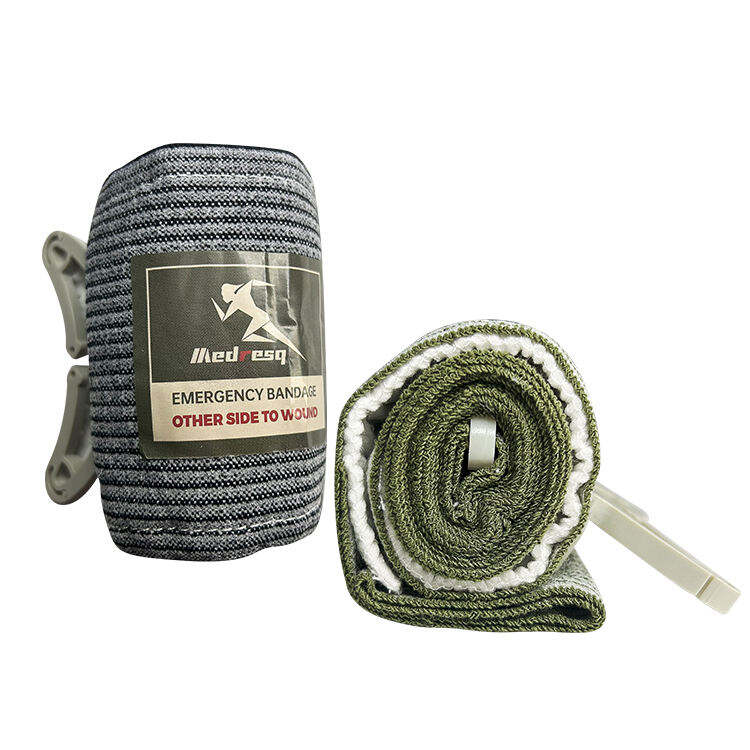Pan fo ymateb meddygol brys yn cael ei ystyried, rhaid i reoli gwaedodi fod yn un o'r brif bryderon. Mae gwaedodi fawr yn un o'r prif achosion marwolaeth mewn achosion traedigaeth, a method a dôl effeithiol i stopio gwaedodi yw elfen hanfodol ar gyfer atgyweiriwrion cyntaf, meddygon milwrol, a hefyd ar gyfer y bobl ar y stryd. Ymhlith y mathau hyn o dôl, fe wnaeth y Bandyn Traedigaeth Israel gael llawer o sylw. bandiega trauma mae'r Bandyn Traedigaeth Israel yn adnabyddus o'i gilydd am ei effeithloni a'i ddibyniaeth, a nawr yn un o'r eitemau meddygol safonol yn y ffordd o hyd. Fodd bynnag, beth yw'r peth sydd yn ei wneud yn well na'r rhai eraill ar gyfer rheoli gwaedodi?

Rôl y bariau pwysau sydd wedi'u hadeiladu o fewn ar gyfer hemostasis
Ymhlith y nodweddion unigryw bandadŵr traumata Israelaidd yw'r ffaith ei fod wedi'i ddylunio gyda bar bwriadol sydd yn chwarae rôl allweddol mewn hemostasis neu atal llif gwaed. Mae'r band yn cael ei ddarparu gyda'r bar pwysau sydd fel arfer yn cael ei wneud o fewn plastig hanner-caled sy'n gwneud felly ei roi pwysau canolbwyntiedig yn uniongyrchol ar y drin. Mae hyn yn cynnig toriad sylweddol ar y dulliau traddodiadol o bandadu sydd yn cynnwys defnyddio bandaid yn unig trwy gyswllt neu'n hamdden dros y rhan anafredig.
Mae'n caniatáu hefyd bwriad gwasgedig sydd yn helpu i reoli'r llif gwaed i allan o'r corff, yn ogystal â lleihau'r tebygolrwydd o amharu ar y llif gwaed mewn tissued eraill ym mhawr. Mae'r bar gwasgedig yn cloi'r safle o dan wasgfa sydd yn gweithio'n well na bandiau crymyll cyffredinol yn atal y gwared. Mae'r strategaeth uniongyrchol hon yn effeithiol mewn sefyllfaoedd go iawn ble mae'n bosibl nad yw claf yn derbyn cymorth meddygol proffesiynol yn y pryd.
Ychwanegol, mae'r bar gwasgedig yn syml a'i esbonio ei hun, sydd yn gyfleus i'r rhai sydd â gwybodaeth gyfyngedig yn hyfforddiant meddygol. Mae'n hawdd ei osod a'i addewid gan un atebwr, sydd yn caniatáu defnydd llwyddiant gan unigolyn ble mae cymorth meddygol yn absennol. Mae'r hawst ar gyfer defnyddwyr yn un o'r fanteision mawr mewn sefyllfaoedd anogaidd ble mae amser hefyd yn hanfodol.

Cymharu Bandiau Israelaidd â Bandiau Crysmyll Safonol
Wrth gymharu nodweddion ystod o bandynnau Israelaidd â gorchuddion crymedd safonol, mae sawl o ffactorau sy'n gwahaniaethu rhwng them. Mae'r genedlaeth henaf o orchuddion crymedd yn aml yn sylfaenach, yn gyffredinol yn cynnwys pad sterol sydd â bandyn amgylchol. Er eu bod yn defnyddiol yn gofalu gwaredol â chreu, nid oes ganddynt sawl o nodweddion pwysig sydd yn hanfodol mewn achosion traumad mawr.
Yn gyntaf, mae bandynnau Israelaidd wedi'u gwneud i weithredu llawer o bwrpasau. Maent yn cyfuno gorchudd nad yw'n gludo, bandyn a mecanwaith i gymhwyso pwysau mewn un pecyn. Bydd y fath fodel unedig yn lleihau nifer y teclynion gwahanol sydd eu hangen i wynebu gwaedodiad traumataidd yn effeithiol a bydd'r broses yn cael ei symlhau. O'r llall, bydd orchuddion crymedd arferol yn gofyn am ddefnydd ychwanegol o ddarpariaethau fel gaws neu deipio meddygol er mwyn eu galluogi, a felly mae'n dod yn broblem yn sefyllfaoedd anogaidd.
Mae bandŵn Israel hefyd yn dibynnu ar effaith y seilwaith sydd hefyd yn bwysig. Mae'r gwarw chwifl yn gweithredu pwysau hyblyg ond cryf sy'n helpu ei ffitio o amgylch anafiadau o lawer o feintiau a safleoedd nad ydynt yn safonol yn fwy hyblyg na gwarwadau nad ydynt yn seilwyr. Bydd hyn yn awgrymu pwysau cyson yn cael ei weithredu, sydd yn hanfodol wrth atal y bandŵn rhag symiau neu ddod yn losli.
Mae'r fanteis arall yn system cau bandŵn Israel. Mae'r bandŵn hyn yn cau fel arfer gan ddefnyddio bar neu brennod ac nid oes angen rhagor o glud neu gyswllt i'w segurio. Mae hyn yn arbennig o ddefnyddiol pan mae'r unigolyn yn dymuno i'r bandŵn aros yn y lle pan fo'n rhaid arhos ar y bandŵn yn ystod trafnidiaeth o hyd neu weithgarwch symudol.
Ychwanegol, mae bandŵn traumata Israel yn enw yn ddynn. Maen nhw'n cael eu gwneud o ddeunyddiau fel arall yn gallu tyfu yn erbyn tywylledd ddifrifol a heithrio mewn unrhyw amgylchiadau. Mae eu hyblygrwydd yn rhoi hygrededd hyd yn oed ar y maes o fryn neu le ble mae'n ddigwyddiant ble mae gohebyddion arferol yn methu.
Ychwanegol, mae bandynnau traumata Israel yn cael eu profi'n ddifrifol yn yr amgylchedd milwrol, hynny yw, mae ganddynt wedi heithrio rhai defnyddion go iawn sydd angen perfformiad uchel. Mae hyn yn cynnig gwarant am ansawdd a effeithloni, nad oes gan bandynnau cywasgedd safonol, sy'n aml yn cael eu defnyddio i drin sifiliaid, o faint o ysbryd.
I grynhoi, mae bandyn traumata Israel yn sefyll allan oherwydd ei effeithloni ar nodweddion newydd a chyfleustra ymarferol wrth ddod o hyd i reolaeth gwaedogi brys. Wrth siarad am y bar bwriadol sydd wedi'i adeiladu a'i gymharu â'r bandynnau cywasgedd a ddefnyddir yn gyffredin, gellir dweud ei fod yn un o'r ffactorau nad oes modd anwybyddu pan mae un yn siarad am draumata a'u healu. Gall y bandyn Israel aros â'r hybu angenedig i broses beri o reolaeth gwaedogi gan feddyg hyfforddedig neu deithiwr.
 EN
EN
 FR
FR
 DE
DE
 IT
IT
 JA
JA
 KO
KO
 RU
RU
 ES
ES
 AR
AR
 BG
BG
 HR
HR
 DA
DA
 NL
NL
 FI
FI
 EL
EL
 NO
NO
 PL
PL
 PT
PT
 RO
RO
 SV
SV
 TL
TL
 ID
ID
 SR
SR
 UK
UK
 VI
VI
 SQ
SQ
 TH
TH
 TR
TR
 AF
AF
 MS
MS
 CY
CY
 IS
IS
 HY
HY
 AZ
AZ
 KA
KA
 MN
MN
 MY
MY
 KK
KK
 UZ
UZ
 CS
CS



